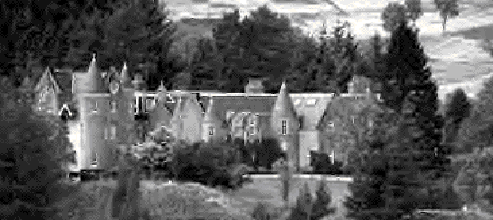Clan of the Cat | home
Dalmunzie Castle

Dalmunzie History
Although hidden at the end of a quiet and secluded glen, Dalmunzie has been witness to many events over thousands of years. The visitor today can easily be unaware that Dalmunzie was once home to hundreds of people speaking a language that has disappeared only recently. The standing stone and burial cairn near the church date from the Bronze age (2000BC) when people were first settling the area, and the former fermtoun of Cuthil (gaelic for clearing in the forest) is of ancient origin and indicates a time when the glen was still heavily wooded.
Legends and history abound in the area including the death of Diarmid and his tomb, the battle of the caterans, tales of Cam Ruadh, the mighty MacCombie Mor and the finding of the Dalmunzie sword.
Dalmunzie’s written record begins in 1510 when Sir William Scott is on record granting lands including Dalmunzie to John Fergusson of Dunfallandy.The first recorded Laird was Robert MacRitchie who along with his son Duncan ‘Cattanach’ MacRitchie were declared rebels in 1584 & 1589. They lived in the original Dalmunzie Castle which stood near the 6th tee of the golf course. Robert declared MacKintosh to be his native chief in 1595 and from this point until 1647 the Lairds were termed as MacKintosh alias MacRitchie. Whether the family were related to the MacKintosh’s or looking for protection is uncertain. A detailed account of the clan history notes ‘It is difficult to account for the granting of that band and the acknowledgement of MacKintosh as their "natyff cheiff" unless there was belief they were bound by ties of birth and blood’ .
Robert's Great-Grandson Robert MacKintosh, 3rd of Dalmunzie fought in the Civil war with James Graham Marquis of Montrose in 1645 and was instrumental in building Dalmunzie up to the estate it is today. The men of Dalmunzie along with those of Glenshee were ardent Jacobites fighting at both Sheriffmuir in 1715 and the ill-fated Battle of Culloden in 1746.
In those days, the glen must have been very different. Dalmunzie Castle stood on the other side of the burn above Dalmunzie fermtoun with 11 cottages, a mill and enclosures nearby. The glen between the Hotel and the gatehouse was heavily populated with perhaps 150 people living in hamlets and farms on both sides of the present driveway. Lenoch-more, Lenoch-beg & Balneton were on the south side of the burn. Sheneval, Wester Spittal, West, Mid & East Cuthell on the north side. All of their ruins can be found by walking the hill dykes on both sides of the glen, with a map and full details of the settlements available in the room compendiums.
The MacKintosh Laird's of Dalmunzie had moved to London by the mid 1700's and after a turbulent history would hold onto their lands until the early 1900’s. Howeverthe period 1782-1813 saw them lose Dalmunzie due to financial difficulties and it was during this time in 1790 that the minister for Glenshee made the entry that 35 families were evicted from Dalmunzie. Like many other estates Dalmunzie had been driven into the improvement era with sheep taking the place of the tenants who had lived in the glen for centuries.
Dalmunzie castle itself had fallen into ruins and an L shaped hunting lodge was built on the present site of the hotel in 1874 by Dr Charles Hills Macintosh 10th Laird of Dalmunzie. A larger L shaped lodge was built over this in 1884, a Victorian wing added in the 1890's and the building and estate leased for shooting parties. Hugh Richard Duncan Mackintosh, 11th Laird of Dalmunzie was the last MacKintosh, dying childless in London in 1916. It was over this period that the Gaelic language which had been in use for thousands of years in Glenshee finally disappeared.
Over three hundred and fifty years of ownership by the Macintoshes came to an end when Dalmunzie was purchased in 1920 by Sir Archibald Birkmyre who had leased the property as a shooting retreat since 1907.